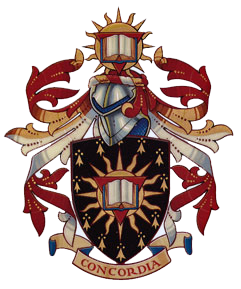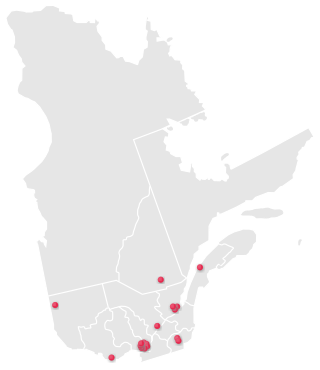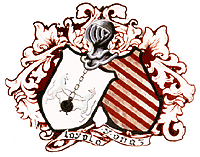
Concordia University is an English-language public research university located in Montreal, Quebec, Canada. Founded in 1974 following the merger of Loyola College and Sir George Williams University, Concordia is one of the three universities in Quebec where English is the primary language of instruction. As of the 2022–23 academic year, there were 49,898 students enrolled in credit and non-credit courses at Concordia, making the university among the largest in Canada by enrolment. The university has two campuses, set approximately 7 kilometres apart: Sir George Williams Campus is the main campus, located in the Quartier Concordia neighbourhood of Downtown Montreal in the borough of Ville Marie; and Loyola Campus in the residential district of Notre-Dame-de-Grâce. With four faculties, a school of graduate studies and numerous colleges, centres and institutes, Concordia offers over 400 undergraduate and over 120 graduate programs and courses.

The Concordia Stingers are the athletic teams that represent Concordia University in Montreal, Quebec, Canada. They compete with other schools in Canadian Interuniversity Sport, and more specifically in Réseau du sport étudiant du Québec. The Stingers were established in 1974 when Sir George Williams University and Loyola College merged to form Concordia University and replaced the preceding Sir George Williams Georgians and Loyola Warriors.

Sir George Williams University was a university in Montreal, Quebec, Canada. It merged with Loyola College to create Concordia University on August 24, 1974.
Marcel Danis, is a Canadian university administrator, lawyer and former politician.

Côte-des-Neiges–Notre-Dame-de-Grâce is a borough (arrondissement) of Montreal, Quebec, Canada. The borough was created following the 2002 municipal reorganization of Montreal. It comprises two main neighbourhoods, Côte-des-Neiges and Notre-Dame-de-Grâce, both former towns that were annexed by the city of Montreal in 1910.
Loyola High School is a co-educational subsidized private Roman Catholic school, adhering to the Jesuit tradition, for grades 7–11. The school is located in the Loyola District of the Côte-des-Neiges–Notre-Dame-de-Grâce borough in Montreal, Quebec, Canada. It was established in 1896 by the Society of Jesus as part of Loyola College, at the request of the English Catholic community in Montreal. It is named after St. Ignatius of Loyola, who founded the Jesuit Order in 1534.

Collège Sainte-Marie was a college in Montreal, Quebec, Canada. It ceased to exist in 1969, when it was merged into UQAM.
Gustave Gingras was a Canadian physician and founder of the Montreal Institute of Rehabilitation in 1949.

With access to six universities and twelve junior colleges in an 8 kilometre (5 mi) radius, Montreal, Quebec (Canada) has the highest proportion of post-secondary students of all major cities in North America. This represents roughly 248,000 post-secondary students, one of the largest numbers in the world.

George Washington Dixon was a professional Canadian football player and a Canadian Interuniversity Sport football coach.
Edmund Francis "Ed" Enos was a Canadian Football League player and university athletics administrator.
The Concordian is an independent, entirely student-run newspaper published weekly for the students of Concordia University; its offices and hard-copy distribution centres are located in Montreal, Quebec, Canada.

De Maisonneuve Boulevard is a major westbound boulevard located in downtown Montreal, Quebec, Canada. It is named after the founder of Montreal, Paul Chomedey de Maisonneuve. It is a one-way street westbound.

Higher education in Quebec differs from the education system of other provinces in Canada. Instead of entering university or college directly from high school, students in Quebec leave secondary school after Grade 11, and enter post-secondary studies at the college level, as a prerequisite to university. Although both public colleges (CEGEPs) and private colleges exist, both are colloquially termed CEGEPs. This level of post-secondary education allows students to choose either a vocational path or a more academic path.

Concordia University Library is the library system at Concordia University in Montreal, Quebec, Canada. Concordia University has three library locations. The R. Howard Webster Library is located in the J.W. McConnell Building on the Sir George Williams Campus and the Georges P. Vanier Library is located on the Loyola Campus. On September 2, 2014, the Library opened the Grey Nuns Reading Room, a silent study space for Concordia students located in the former Chapel of the Invention of the Holy Cross. The Reading Room has seating for 192 students, with an additional 42 chairs in small reading rooms. A Political Science student was the first to enter.
Marc Gervais, S.J., was a Canadian Jesuit priest, film scholar, writer, and film consultant.

St. Ignatius Church is a Roman Catholic Parish church in Notre-Dame-de-Grâce, Montreal West, Quebec. It was founded by the Society of Jesus in 1917 as an English-speaking parish. It is next to Loyola High School and the Loyola Campus of Concordia University.

The Concordia Stingers football team represents Concordia University in Montreal, Quebec, in the sport of Canadian football in the RSEQ conference of U Sports. The Concordia Stingers football program was created in 1974 from the amalgamation of the Loyola Warriors and Sir George Williams Georgians. The team has won three Dunsmore Cup conference championships, in 1982, 1993, and 1998. In 1998, the Stingers also made their first and only appearance in the national championship which was a loss to the Saskatchewan Huskies in the 34th Vanier Cup game.

The High School of Montreal was an English-language high school founded in 1843, serving Montreal, Quebec, Canada, in the area eventually known as the Golden Square Mile. It was less formally known as Montreal High School and from 1853 to 1870 was called the High School of McGill College, or the High School Division.
















